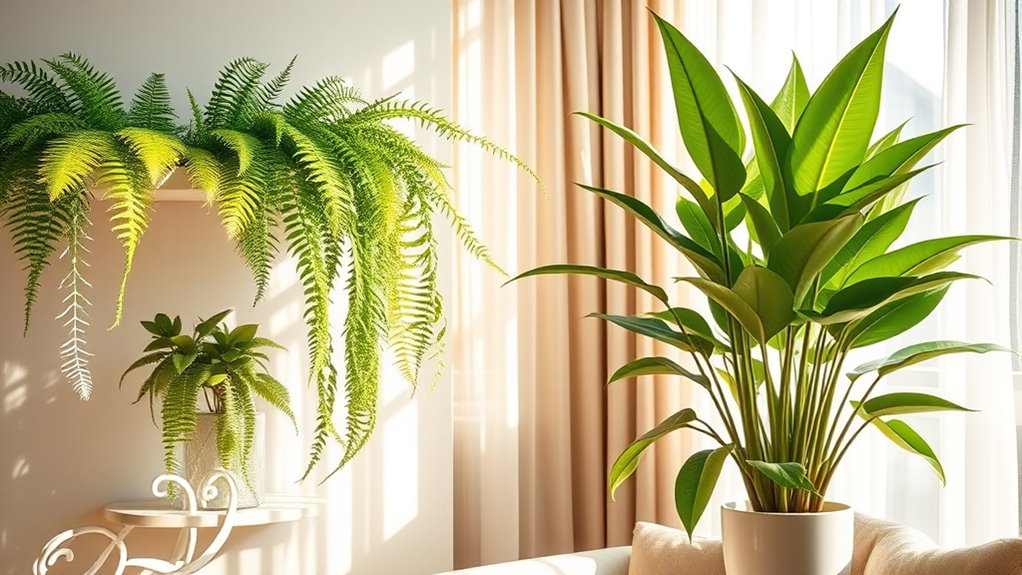Air-purifying plants can bring health and freshness to your home by removing toxins like carbon dioxide and formaldehyde from the air. With just 2-3 plants per 9 square meters, you’ll boost indoor air quality and create a calming atmosphere. Plus, many varieties are low-maintenance and pet-friendly! Not only do they enhance your well-being, but they also add aesthetic appeal to your space. Explore some top options to find the best fit for your home!
Key Takeaways
- Air-purifying plants improve indoor air quality by removing harmful pollutants like carbon dioxide, formaldehyde, and benzene.
- Incorporating 2-3 plants per 9 square meters maximizes their air-purifying effects.
- Popular choices like Spider Plant and Snake Plant are low-maintenance and effective in toxin removal.
- These plants not only enhance air quality but also create a calming and aesthetically pleasing environment.
- Regular care, such as proper watering and dusting leaves, ensures optimal health and effectiveness of your indoor plants.
The Benefits of Air Purifying Plants
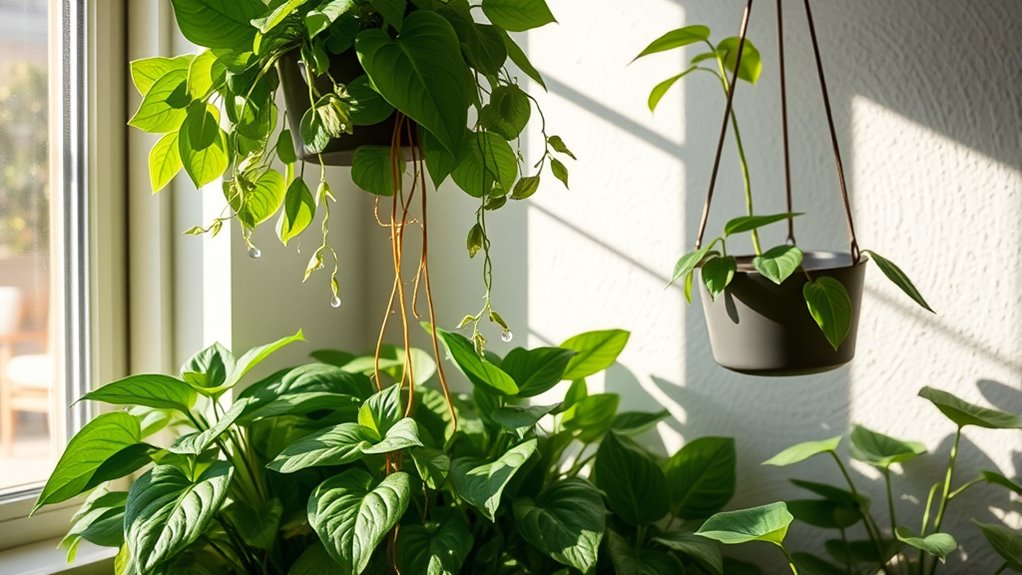
While you may not realize it, adding air-purifying plants to your home can greatly boost your indoor air quality.
These plants actively improve air quality by removing indoor air pollutants like carbon dioxide, formaldehyde, and benzene. Incorporating two to three air-purifying plants per 9 square meters can lead to ideal results, creating cleaner air in your indoor environments. Additionally, many air purifiers, especially those with HEPA filtration, work synergistically with plants to enhance air purification. Studies have shown that plants can effectively reduce indoor air toxins, complementing the benefits of air purifiers. Furthermore, selecting non-toxic plants such as Areca Palm ensures a safe environment for pets while still contributing to cleaner air. Regular home cleaning practices can further assist in maintaining a healthy atmosphere, ensuring that the air remains free from dust and allergens.
Incorporating 2-3 air-purifying plants per 9 square meters can significantly reduce indoor air pollutants and enhance air quality.
Plants such as the Boston Fern and Spider Plant are safe for pets and children, making them perfect choices for family homes.
Cleaner air enhances overall well-being, reducing symptoms of fatigue, respiratory issues, and allergies. Plus, the aesthetic value of greenery fosters a calming atmosphere, promoting mental health benefits in your space. Additionally, maintaining optimal performance of air purifiers alongside plants can further enhance indoor air quality.
Embrace these plants to elevate your home’s environment!
Top Houseplants for Clean Air
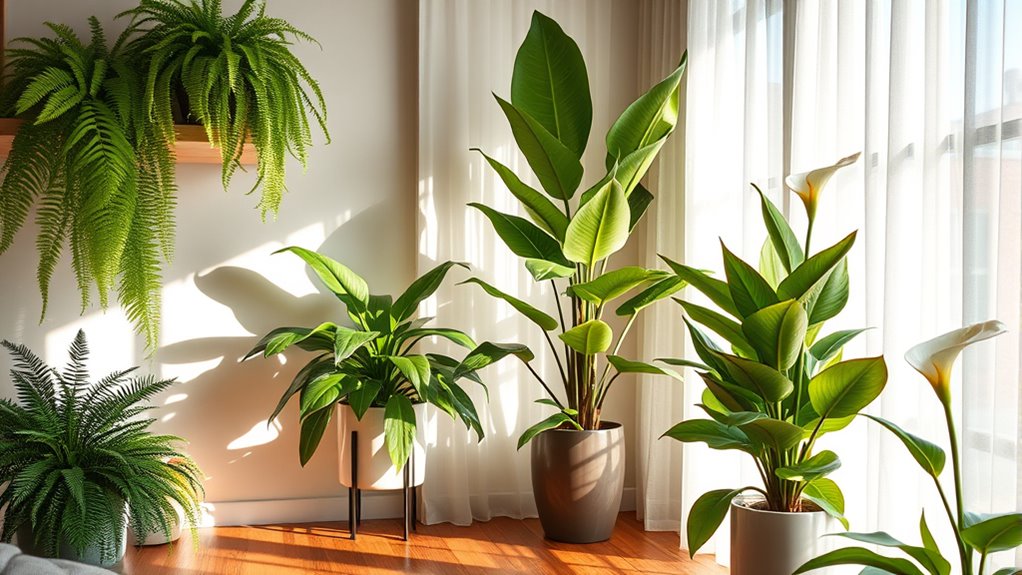
- Spider Plant: Great for beginners, it effectively removes xylene and formaldehyde with low maintenance.
- Boston Fern: Non-toxic to pets, it excels at eliminating cigarette smoke and formaldehyde but needs humidity.
- Snake Plant: Also known as Mother-in-Law’s Tongue, it thrives on neglect and removes benzene.
- English Ivy: This plant eliminates carbon monoxide and requires careful watering to avoid overwatering.
The Golden Pothos is another resilient option, removing xylene and formaldehyde while thriving in various light conditions. Incorporating plants like these can enhance your indoor environment and contribute to improved gut microbiota, promoting overall health and well-being. Enjoy the benefits of cleaner air!
Essential Care Tips for Indoor Plants
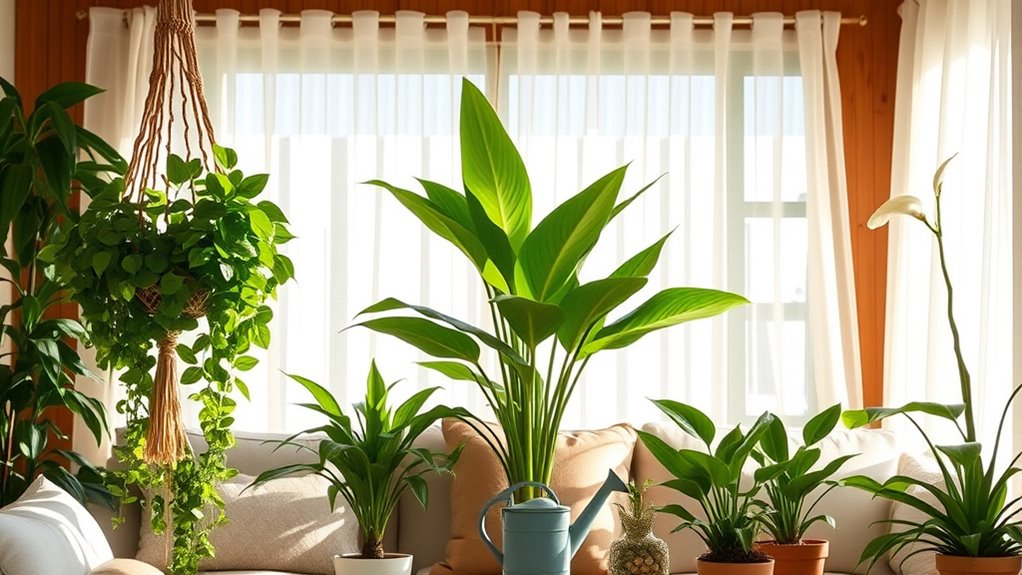
Taking care of your indoor plants means understanding their unique needs. You need to pay attention to their watering requirements, light conditions, and soil type to help them thrive. Additionally, incorporating aesthetic hooks can enhance the overall decor while providing practical support for your plants. Remember, establishing a budget for plant care supplies can help ensure you have the resources necessary for maintaining a healthy indoor garden. It’s also important to be aware of essential oil safety when using aromatherapy around plants, as some oils can affect their health. Furthermore, ensuring proper hydration is crucial for the vitality of both your plants and the indoor environment.
Watering Requirements
Understanding the watering requirements of air-purifying plants is essential for their health and growth. Each plant has unique needs, so it’s important to tailor your watering routine accordingly.
Here are some key tips:
- Spider Plants: Water 2-3 times a week, keeping soil slightly moist.
- Boston Ferns: Regular watering is crucial to maintain moisture, especially in dry indoor environments.
- Snake Plants: Water every two weeks, allowing soil to dry out completely to prevent root rot.
- ZZ Plants: These drought-tolerant plants thrive on low-maintenance care, needing water only when the soil is dry.
Pay attention to these watering requirements, and your air-purifying houseplants like the Peace Lily will flourish in your indoor environment.
Light Conditions
While you may think all plants can thrive in any light, air-purifying plants actually have specific light requirements that are vital for their health.
Some, like the Peace Lily and Snake Plant, flourish in low-light conditions, while others, such as the Spider Plant and Bamboo Palm, thrive in bright, indirect sunlight.
Proper light conditions are essential for maintaining ideal air purification; insufficient light can stunt growth and reduce air-purifying qualities.
To enhance plant health, position light-loving plants near windows and place more tolerant varieties in shaded spots.
By regularly monitoring and adjusting their placements, you can improve their air-cleaning abilities.
A diverse range of plants in your indoor environment guarantees effective air purification throughout your space.
Soil and Fertilization
Light conditions aren’t the only factors that influence the health of air-purifying plants; the right soil and fertilization practices play a significant role too.
To guarantee your plants thrive, keep these tips in mind:
- Use well-draining soil to prevent waterlogging and root rot.
- Regularly refresh soil through repotting to provide essential nutrients.
- Apply balanced fertilizers during the growing season for best growth.
- Maintain higher humidity levels, especially for Rubber Plants and Boston Ferns.
The Science Behind Air Purification
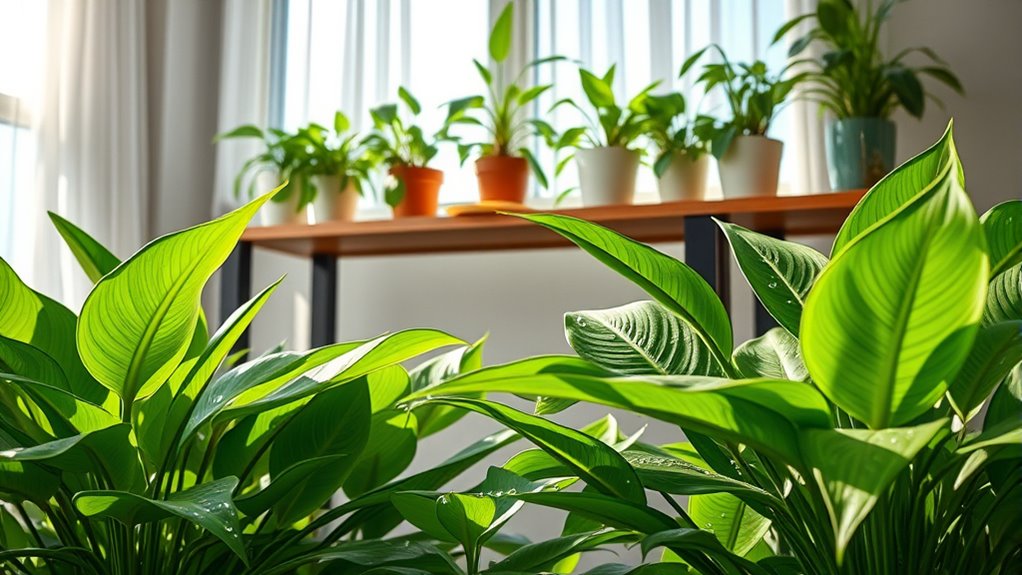
Understanding how plants purify air starts with photosynthesis, where they turn carbon dioxide and sunlight into oxygen.
You’ll find that plants also play an essential role in removing toxins like xylene and ammonia, cleaning your indoor environment.
Photosynthesis Process Explained
As you explore the fascinating process of photosynthesis, you’ll discover how plants transform sunlight into energy, an essential mechanism that not only sustains their growth but also plays an important role in purifying the air around you.
Through photosynthesis, indoor plants utilize chlorophyll to absorb light, taking in carbon dioxide and releasing oxygen. This natural process enhances air quality by detoxifying the environment.
Here are some key benefits of photosynthesis in air-purifying plants:
- Increases oxygen levels indoors
- Absorbs harmful toxins like benzene and formaldehyde
- Reduces carbon dioxide levels
- Filters pollutants effectively
Toxin Removal Mechanism
While you might think of plants as mere decorative elements in your home, their ability to purify the air is rooted in a fascinating science.
Air-purifying plants are masters at removing toxins through a process called phytoremediation. They absorb harmful substances via their leaves and roots, all while performing photosynthesis. During this process, chlorophyll captures sunlight, converting carbon dioxide into oxygen and detoxifying indoor pollutants like xylene, benzene, and formaldehyde.
NASA’s Clean Air Study highlighted the effectiveness of plants in enhancing air quality. To maximize their purifying capabilities, it’s recommended to have at least two to three plants per 9 square meters.
Species like Boston Fern and Spider Plant are particularly effective in removing toxins and improving your indoor environment.
Creating a Healthy Indoor Environment

Creating a healthy indoor environment is easier than you might think, especially with the help of air-purifying plants. They effectively remove indoor air pollutants, improving indoor air quality and creating a calming atmosphere.
With so many benefits of cleaner air, incorporating green leaves into your space has never been more essential.
Consider these tips for a healthier living space:
- Select plants that purify, like the Boston Fern or Spider Plant.
- Aim for 2-3 air-purifying plants per 9 square meters.
- Keep your plants thriving in low light if necessary.
- Maintain them by dusting leaves and watering properly.
Pet-Friendly Air Purifying Options
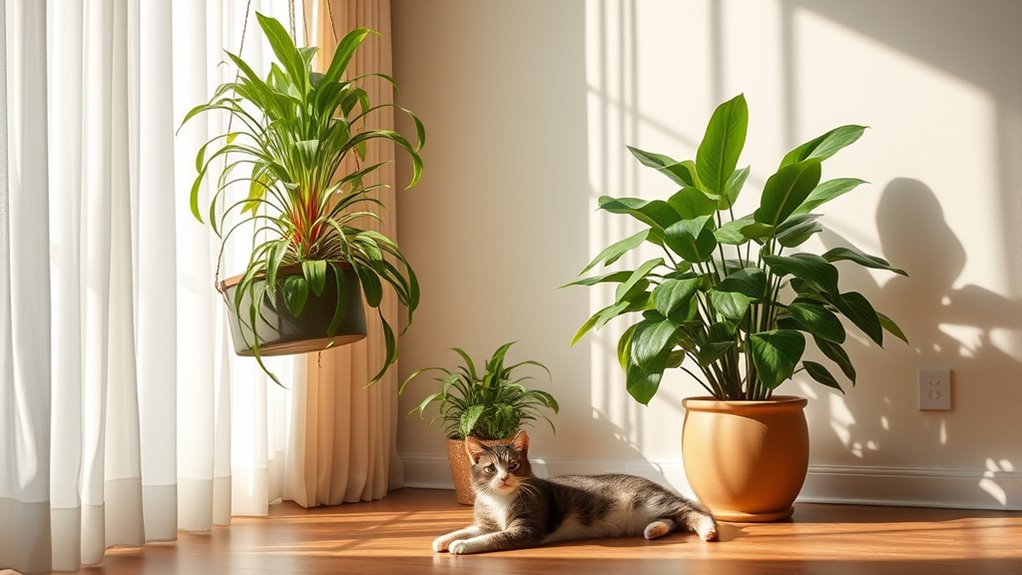
If you’re a pet owner looking to enhance your indoor air quality, there are plenty of air-purifying plants that won’t harm your furry friends.
The Spider Plant is a fantastic pet-friendly option that efficiently eliminates toxins like formaldehyde and xylene.
Boston Ferns thrive in humid environments and remove pollutants such as cigarette smoke and benzene, making them ideal for your home.
Areca Palms not only purify the air by removing toxins but also add a tropical feel to your indoor spaces.
Meanwhile, the resilient ZZ Plant clears toxins like benzene and toluene, thriving in low-light conditions.
Enhancing Indoor Aesthetics With Plants
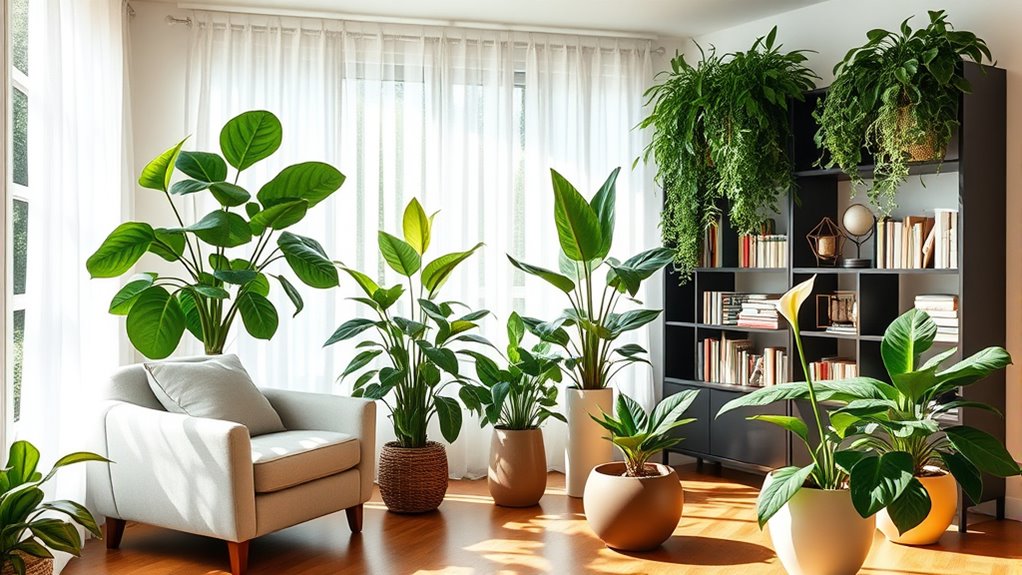
Air-purifying plants do more than just clean the air; they can transform your living space into a vibrant sanctuary.
By incorporating these plants, you enhance your home decor while creating a calming atmosphere.
Enhance your home decor and foster tranquility by embracing the beauty of air-purifying plants.
Consider these benefits of air-purifying plants:
- Lush foliage adds life to indoor spaces.
- Unique shapes like those of Monstera serve as natural focal points.
- Contrast textures from a variety, like Golden Pothos and ZZ Plants, enrich your decor.
- Sophisticated touch from plants like Rubber Plant elevates modern aesthetics.
Frequently Asked Questions
Which Indoor Plant Purifies the Air the Most?
If you’re looking for the indoor plant that purifies the air the most, consider the Boston Fern. It excels at removing formaldehyde, making it an excellent choice for improving air quality.
Spider Plants, Peace Lilies, and Bamboo Palms also do a great job, each tackling different toxins.
Snake Plants are unique because they convert carbon dioxide into oxygen at night, helping to keep your space fresh around the clock.
Do Plants Really Help Indoor Air Quality?
Sure, you could think that those houseplants are just decorative little green things, right?
But in reality, they’re your secret air quality superheroes! Yes, plants really do help improve indoor air quality. They absorb carbon dioxide and filter out harmful pollutants with their leaves and roots.
So, while you’re binge-watching your favorite show, your leafy friends are busy cleaning the air.
Just don’t forget to dust them off occasionally to keep that superhero power strong!
What Plant Removes 78% of Airborne Mold?
If you’re looking for a plant that removes 78% of airborne mold, the Boston Fern‘s your best bet.
It thrives in humid environments, so placing it in damp areas of your home will help. Make sure it gets bright, indirect sunlight and keep the humidity consistent.
Regularly misting its leaves can boost its air-purifying abilities. For even better results, consider adding multiple Boston Ferns to your space for enhanced air quality.
Do Indoor Plants Improve Your Health?
Picture a lush green oasis in your living room, where vibrant leaves sway gently in the breeze.
Indoor plants can indeed improve your health by filtering out harmful pollutants and boosting air quality. You’ll breathe easier and feel more energized.
Plus, nurturing these plants can reduce stress, creating a calming atmosphere that enhances your mental well-being.
Conclusion
Incorporating air-purifying plants into your home is like inviting a refreshing change indoors. Not only do these green companions enhance your space’s beauty, but they also work tirelessly to improve the air you breathe. With a little care, you’ll create a healthier environment that nurtures both body and mind. So, go ahead and let nature’s air filters thrive in your home, transforming your indoor oasis into a sanctuary of well-being.
